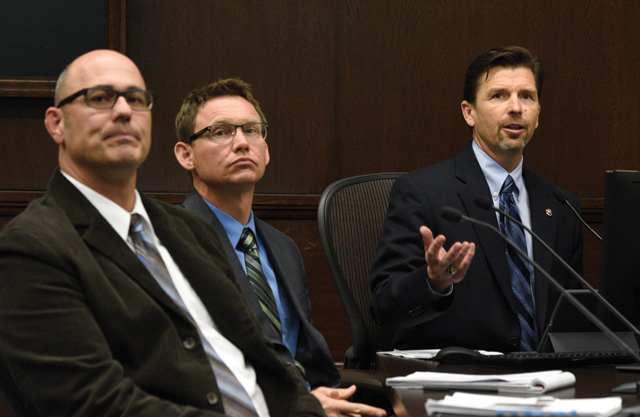Attacking Death with Vision Zero and Cans of Paint

Armed with a few cans of paint and a reformer’s zeal when it comes to City Hall’s new “Vision Zero” policy, Santa Barbara traffic engineers are hoping to take on what they see as a culture of complacency when it comes to the dangers associated with car travel. “The airline industry doesn’t accept death as an inevitable fact of life,” said transportation manager Rob Dayton. “We shouldn’t either.”
This Tuesday, Dayton and engineer Derrick Bailey secured unanimous council support for a road restriping project that will reduce a stretch of Las Positas Road from four lanes to three. By narrowing the road, the modest, low-budget change — of around $20,000 — is designed to increase road safety by reducing speed. The “missing” lane will be used to create a turn lane from McCaw Avenue to San Onofre Street.
A stretch along Cabrillo Boulevard was proposed to go from four lanes to two, but in deference to neighborhood concerns, city staff was directed to explore six different options. The cannibalized lane space was to be used to create new vertical backed-in parking spaces, but staff will also look at other ways to restructure Cabrillo to minimize collision patterns. Public workshops are upcoming to discuss the alternatives.
Dayton reported there were 24 serious injury–inducing accidents along Las Positas in the past 10 years. Along Cabrillo, he said, there’d been another 18 in the past 10 years. Cops and firefighters, he said, have long been accustomed to playing the role of hero. Now, he said, it’s the traffic engineer’s turn.
A few residents living along Las Positas praised the new approach. Alternate transportation advocates with COAST (Coalition for Sustainable Transportation) and the Bicycle Coalition — who successfully led the charge for Vision Zero in 2018 when the council adopted it as a goal — praised the projects even though neither had a bicycle component. Only Councilmember Randy Rowse expressed enthusiasm leavened by caution. “You really can’t fix ‘stupid’ with a policy,” he said, adding that cyclists and pedestrians are not always “innocent bystanders” but often engage in behavior that gives rise to accidents. Dayton noted that pedestrian fatalities decreased by 40 percent in New York City after the adoption of a “Vision Zero” policy.
Correction: This story was corrected on February 12, 2019. The council had not voted in favor of the Cabrillo project; rather, it sent it back to staff due to neighborhood concerns.



